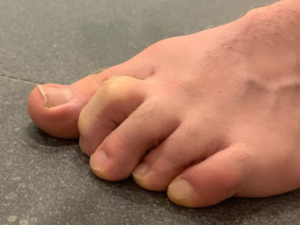What is Claw Toe?
May 19 2024
What is Claw Toe?
Claw toe is a deformity of the toes, characterized by an abnormal bend in the joints of one or more toes. Specifically, the toes bend upward at the joint where they connect to the foot (the metatarsophalangeal joint) and downward at the middle and end joints, giving them a claw-like appearance. This condition can affect any of the smaller toes and often involves multiple toes simultaneously.
Causes of Claw Toe
Several factors can contribute to the development of claw toe, including:
1. Muscle Imbalance:
When the muscles controlling toe movement become imbalanced, they can pull the toes into a claw-like position. This imbalance is often due to neurological conditions, such as cerebral palsy, stroke, or Charcot-Marie-Tooth disease.
2. Footwear Choices:
Wearing tight, narrow, or high-heeled shoes can force the toes into unnatural positions over time, leading to deformities like claw toe.
3. Trauma:
Injuries to the foot or toes can disrupt normal joint function and lead to deformities.
4. Arthritis:
Conditions like rheumatoid arthritis can cause joint inflammation and deformity, including claw toe.
5. Genetic Factors:
Some individuals may be genetically predisposed to developing claw toe due to the structure and biomechanics of their feet.
Symptoms of Claw Toe
The symptoms of claw toe can vary in severity and may include:
– Visible bending of the toe joints, giving the toes a claw-like appearance.
– Pain and discomfort, especially when wearing shoes.
– Corns and calluses forming on the tops or tips of the toes due to friction.
– Redness, swelling, or irritation around the affected joints.
– Limited or painful movement of the toes.
A healthcare professional can diagnose claw toe through a physical examination of the foot. They may also order imaging tests, such as X-rays, to assess the extent of the deformity and identify any underlying causes.
The treatment for claw toe depends on the severity of the condition and the underlying cause. Options include:
1. Non-Surgical Treatments
– Footwear Changes: Switching to shoes with a wider toe box, low heels, and good arch support can relieve pressure on the toes.
– Orthotic Devices: Custom shoe inserts or toe splints can help realign the toes and provide support.
– Physical Therapy: Exercises to strengthen and stretch the toe muscles can improve flexibility and reduce symptoms.
– Medications: Over-the-counter pain relievers and anti-inflammatory drugs can help manage pain and swelling.
2. Surgical Treatments:
– Tendon Release: In cases where tendons are overly tight, releasing or lengthening them can help the toes return to a normal position.
– Joint Fusion: Fusing the affected joints can straighten the toes and provide stability.
– Toe Implants: In some cases, implants may be used to correct the deformity.
Preventing Claw Toe
While not all cases of claw toe can be prevented, taking certain steps can reduce your risk:
– Choose Proper Footwear: Wear shoes that fit well, with adequate room for your toes.
– Maintain Foot Health: Regularly exercise your feet and toes to keep muscles strong and flexible.
– Monitor for Early Signs: Pay attention to any changes in toe alignment or foot discomfort and seek early treatment.
Claw toe is a common but manageable condition. Understanding its causes, recognizing its symptoms, and exploring various treatment options can help you take proactive steps to maintain your foot health. If you suspect you have claw toe or are experiencing foot pain, don’t hesitate to contact us at the Family Foot & Leg Center. Our team of specialists is here to provide you with the best care and treatment options tailored to your needs.



 Fax: (239) 692-9436
Fax: (239) 692-9436 Tel: 239-430-3668
Tel: 239-430-3668
